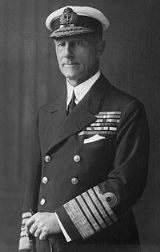
John Jellicoe, 1st Earl Jellicoe
Encyclopedia
Admiral of the Fleet
John Rushworth Jellicoe, 1st Earl Jellicoe, GCB
, OM, GCVO
(5 December 1859 – 20 November 1935) was a British Royal Navy
admiral
who commanded the Grand Fleet at the Battle of Jutland
in World War I. His handling of the fleet at that battle was controversial: he made no serious mistakes and the German High Seas Fleet
retreated to port – at a time when defeat would have been catastrophic for Britain – but at the time the public were disappointed that he had lost more ships (mainly due to dangerous ammunition-handling procedures on British battlecruisers) and had not won a victory as crushing as Trafalgar.
Jellicoe later served as First Sea Lord (professional head of the Royal Navy), but he was removed at the end of 1917 because of differences over policy regarding the war against the U-Boats and his perceived pessimism about Britain's ability to carry on the war.
Viscount Jellicoe served as the Governor-General of New Zealand in the 1920s.
into a seafaring family, Jellicoe joined the Royal Navy
as a cadet
in 1872 and was posted to HMS Britannia
. He was made a midshipman
on the wooden, steam, fully rigged frigate HMS Newcastle
in September 1874. He joined HMS Agincourt
, flagship of the Channel Squadron, in July 1877.
He then spent six months on HMS Alexandra
, flagship of the Mediterranean Fleet
, as signal sub-lieutenant. He was promoted to lieutenant on 23 September 1880. He specialized in gunnery and returned to HMS Agincourt in February 1881. As a lieutenant from HMS Agincourt during the Egyptian war
, he commanded a rifle company in the Naval Brigade at Ismailia
and earned the Egyptian Medal and the Khedive's Bronze Star for this action.
He was appointed to the staff of the gunnery school, HMS Excellent, as a gunnery lieutenant in May 1884. He was then awarded the Board of Trade Silver Medal
in May 1886 for rescuing the crew of a capsized steamer near Gibraltar
when on HMS Monarch
as a gunnery lieutenant. He joined HMS Colossus
in April 1886 and was then in charge of the HMS Excellent experimental department from 6 December 1886 to 10 May 1888. He was appointed assistant to the Director of Naval Ordnance later that year.
Promoted to commander
in June 1891, he joined the Mediterranean Fleet
at Malta
on HMS Sans Pareil
in March 1892. However, he was wrecked on HMS Victoria
when it collided with HMS Camperdown
(the flagship of the Commander-in-Chief of the Mediterranean Fleet, Vice-Admiral Sir George Tryon
) off Tripoli on 22 June 1893; the Admiral, 21 officers and 350 men drowned. Jellicoe was then appointed commander of the new flagship, HMS Ramilies
, in October 1893.
 Promoted to the rank of captain in January 1897, he became a member of the Admiralty's Ordnance Committee.
Promoted to the rank of captain in January 1897, he became a member of the Admiralty's Ordnance Committee.
Jellicoe served as chief of staff to Vice Admiral Sir E. H. Seymour
during the Seymour expedition to relieve the legations at Peking
in June 1900. He was badly wounded and told he would die, but confounded the attending doctor and chaplain by living. In November 1900 he was appointed C.B.
for services rendered during the Peking expedition.
He became Naval Assistant to Controller of the Navy in February 1902. He married Gwendoline Cayzer in London in July 1902.
Also in 1902 he was decorated by the German Emperor
with the Red Eagle
, 2nd class, with Crossed Swords. He became captain of HMS Drake, part of the Cruiser Squadron, in August 1903.
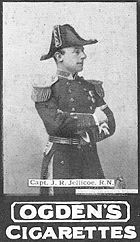
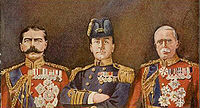
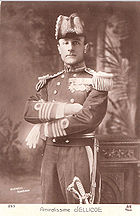
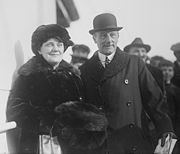 Under Admiral John Fisher, 1st Baron Fisher, Jellicoe was made Director of Naval Ordnance in 1905. He was appointed K.C.V.O.
Under Admiral John Fisher, 1st Baron Fisher, Jellicoe was made Director of Naval Ordnance in 1905. He was appointed K.C.V.O.
on the occasion of the Review of the Home Fleet in the Solent by HM King Edward VII on 3 August 1907. He was also Aide-de-Camp
to the King from 8 March 1906 to 8 February 1907.
Jellicoe was promoted to Rear-Admiral in February 1907 during his tenure as Director of Naval Ordnance. He pushed hard for funds to modernise the navy, supporting the construction of new classes of dreadnought battleships. Jellicoe became very knowledgeable about his profession, much more so than most of his contemporaries, especially appreciating the strong points of the Kaiserliche Marine
(German navy). He supported F. C. Dreyer
's improvements in gunnery fire-control system
s, and favoured the adoption of Dreyer's "Fire Control Table", a form of mechanical computer for calculating firing solutions for warships.
He was appointed second-in-command of the Atlantic Fleet in August 1907 and hoisted his flag in HMS Albemarle
. He went on to be a Lord Commissioner of the Admiralty and Third Sea Lord and Controller of the Navy
in October 1908. He was appointed Vice-Admiral commanding the Atlantic Fleet on 20 December 1910 and hoisted his flag in HMS Prince of Wales
. He advanced to K.C.B.
on the Coronation of King George V on 19 June 1911.
, Commander-in-Chief of the Home Fleet, was removed by First Lord of the Admiralty Winston Churchill. Vice-Admiral Jellicoe was promoted to Admiral and assigned command of the renamed Grand Fleet in Admiral Callaghan's place, though he was appalled by the treatment of his predecessor. Churchill – referring to the fact that a German naval victory would have made it impossible for Britain to supply her army in France, or even import food – described Jellicoe later as 'the only man on either side who could lose the war in an afternoon'.
Jellicoe was in command of the British Grand Fleet at the Battle of Jutland
(1916), history's largest (and only major) clash of dreadnought
s, albeit an undecisive one. His handling of the Grand Fleet during the battle remains controversial, with some historians faulting the battlecruiser
commander, Admiral David Beatty
. However, Jellicoe certainly made no significant mistakes during the battle: based on limited intelligence, he correctly deployed the Grand Fleet with a turn to port so as to "cross the T
" of the German High Seas Fleet as it appeared. After suffering heavy shell damage, the German fleet turned 180 degrees and headed away from the battle. Some critics claimed that he did not pursue the High Seas Fleet because he feared a torpedo attack and overestimated the danger from a massed attack by enemy destroyer
s. At the time the British public were disappointed that the Royal Navy had not won a victory on the scale of Trafalgar.
Admiral Jellicoe was appointed First Sea Lord
in November 1916 and turned over command of the Grand Fleet to Admiral David Beatty. His term of office in 1917 saw Britain brought within danger of starvation by German unrestricted U-Boat warfare
. Jellicoe took a pessimistic view, declaring that nothing could be done to defeat the U-boat
s.
On Christmas Eve 1917, Admiral Jellicoe was rather abruptly dismissed as First Sea Lord by the new First Lord of the Admiralty, Sir Eric Campbell Geddes, and was succeeded by Admiral Rosslyn Wemyss.
Jellicoe was made a Viscount in 1918 and was promoted to Admiral of the Fleet in April 1919, along with David Beatty. Admiral of the Fleet the Viscount Jellicoe served as Governor-General of New Zealand
from September 1920 to November 1924. On his return to England in 1925, he was made an earl.
. He was succeeded in the earldom by his only son George
, then styled Viscount Brocas
.
A bust of Jellicoe rests on Trafalgar Square in London, alongside those of Beatty and Andrew Cunningham
, Admiral of the Fleet in World War II. A blue plaque
stands on the wall of his house in Blacklands Terrace (25 Draycott Place), Chelsea, London.
The junior boarding house at Bearwood College
, Winnersh, UK, is named after Jellicoe.
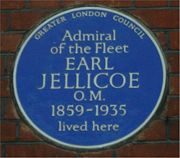 Some of Jellicoe's London residences:
Some of Jellicoe's London residences:
Isle of Wight:
Two of Jellicoe's childhood homes in Southampton:
|-
Admiral of the Fleet (Royal Navy)
Admiral of the fleet is the highest rank of the British Royal Navy and other navies, which equates to the NATO rank code OF-10. The rank still exists in the Royal Navy but routine appointments ceased in 1996....
John Rushworth Jellicoe, 1st Earl Jellicoe, GCB
Order of the Bath
The Most Honourable Order of the Bath is a British order of chivalry founded by George I on 18 May 1725. The name derives from the elaborate mediæval ceremony for creating a knight, which involved bathing as one of its elements. The knights so created were known as Knights of the Bath...
, OM, GCVO
Royal Victorian Order
The Royal Victorian Order is a dynastic order of knighthood and a house order of chivalry recognising distinguished personal service to the order's Sovereign, the reigning monarch of the Commonwealth realms, any members of her family, or any of her viceroys...
(5 December 1859 – 20 November 1935) was a British Royal Navy
Royal Navy
The Royal Navy is the naval warfare service branch of the British Armed Forces. Founded in the 16th century, it is the oldest service branch and is known as the Senior Service...
admiral
Admiral
Admiral is the rank, or part of the name of the ranks, of the highest naval officers. It is usually considered a full admiral and above vice admiral and below admiral of the fleet . It is usually abbreviated to "Adm" or "ADM"...
who commanded the Grand Fleet at the Battle of Jutland
Battle of Jutland
The Battle of Jutland was a naval battle between the British Royal Navy's Grand Fleet and the Imperial German Navy's High Seas Fleet during the First World War. The battle was fought on 31 May and 1 June 1916 in the North Sea near Jutland, Denmark. It was the largest naval battle and the only...
in World War I. His handling of the fleet at that battle was controversial: he made no serious mistakes and the German High Seas Fleet
High Seas Fleet
The High Seas Fleet was the battle fleet of the German Empire and saw action during World War I. The formation was created in February 1907, when the Home Fleet was renamed as the High Seas Fleet. Admiral Alfred von Tirpitz was the architect of the fleet; he envisioned a force powerful enough to...
retreated to port – at a time when defeat would have been catastrophic for Britain – but at the time the public were disappointed that he had lost more ships (mainly due to dangerous ammunition-handling procedures on British battlecruisers) and had not won a victory as crushing as Trafalgar.
Jellicoe later served as First Sea Lord (professional head of the Royal Navy), but he was removed at the end of 1917 because of differences over policy regarding the war against the U-Boats and his perceived pessimism about Britain's ability to carry on the war.
Viscount Jellicoe served as the Governor-General of New Zealand in the 1920s.
Early career
Born in SouthamptonSouthampton
Southampton is the largest city in the county of Hampshire on the south coast of England, and is situated south-west of London and north-west of Portsmouth. Southampton is a major port and the closest city to the New Forest...
into a seafaring family, Jellicoe joined the Royal Navy
Royal Navy
The Royal Navy is the naval warfare service branch of the British Armed Forces. Founded in the 16th century, it is the oldest service branch and is known as the Senior Service...
as a cadet
Cadet
A cadet is a trainee to become an officer in the military, often a person who is a junior trainee. The term comes from the term "cadet" for younger sons of a noble family.- Military context :...
in 1872 and was posted to HMS Britannia
HMS Prince of Wales (1860)
HMS Prince of Wales was one of six 121-gun screw-propelled first-rate three-decker line-of-battle ships of the Royal Navy. She was launched on 25 January 1860...
. He was made a midshipman
Midshipman
A midshipman is an officer cadet, or a commissioned officer of the lowest rank, in the Royal Navy, United States Navy, and many Commonwealth navies. Commonwealth countries which use the rank include Australia, New Zealand, South Africa, India, Pakistan, Singapore, Sri Lanka and Kenya...
on the wooden, steam, fully rigged frigate HMS Newcastle
HMS Newcastle (1860)
HMS Newcastle was a wooden screw frigate, the fifth ship of the name to serve in the Royal Navy....
in September 1874. He joined HMS Agincourt
HMS Agincourt (1865)
HMS Agincourt was one of three Minotaur class ironclads, the sistership of HMS Minotaur and a near sister to HMS Northumberland...
, flagship of the Channel Squadron, in July 1877.
He then spent six months on HMS Alexandra
HMS Alexandra (1875)
HMS Alexandra was a central battery ironclad of the Victorian Royal Navy, whose seagoing career was from 1877 to 1900. She spent much of her career as a flagship, and took part in operations to deter Russian aggression against Turkey in 1878 and the bombardment of Alexandria in 1882.-Background:At...
, flagship of the Mediterranean Fleet
Mediterranean Fleet
Several countries have or have had a Mediterranean Fleet in their navy. See:* Mediterranean Fleet * French Mediterranean Fleet* Mediterranean Squadron * United States Sixth Fleet...
, as signal sub-lieutenant. He was promoted to lieutenant on 23 September 1880. He specialized in gunnery and returned to HMS Agincourt in February 1881. As a lieutenant from HMS Agincourt during the Egyptian war
Urabi Revolt
The Urabi Revolt or Orabi Revolt , also known as the Orabi Revolution, was an uprising in Egypt in 1879-82 against the Khedive and European influence in the country...
, he commanded a rifle company in the Naval Brigade at Ismailia
Ismaïlia
-Notable natives:*Osman Ahmed Osman, a famous and influential Egyptian engineer, contractor, entrepreneur, and politician, was born in this town on 6 April 1917....
and earned the Egyptian Medal and the Khedive's Bronze Star for this action.
He was appointed to the staff of the gunnery school, HMS Excellent, as a gunnery lieutenant in May 1884. He was then awarded the Board of Trade Silver Medal
Sea Gallantry Medal
The Sea Gallantry Medal , is an award for civil gallantry at sea in Great Britain and the Commonwealth. The Merchant Shipping Act 1854 permitted the issue of this award and SGMs were first struck in 1855...
in May 1886 for rescuing the crew of a capsized steamer near Gibraltar
Gibraltar
Gibraltar is a British overseas territory located on the southern end of the Iberian Peninsula at the entrance of the Mediterranean. A peninsula with an area of , it has a northern border with Andalusia, Spain. The Rock of Gibraltar is the major landmark of the region...
when on HMS Monarch
HMS Monarch (1868)
HMS Monarch was the first sea-going warship to carry her guns in turrets, and the first British warship to carry guns of calibre.-Design:...
as a gunnery lieutenant. He joined HMS Colossus
HMS Colossus (1882)
The second HMS Colossus was a Colossus class second-class British battleship, launched in 1882 and commissioned in 1886. She had a displacement of 9,520 tons, and an armament of 4 × 12-inch breechloaders, 5 × 6-inch guns and had a respectable speed of 15.5 knots. She served in the Mediterranean...
in April 1886 and was then in charge of the HMS Excellent experimental department from 6 December 1886 to 10 May 1888. He was appointed assistant to the Director of Naval Ordnance later that year.
Promoted to commander
Commander
Commander is a naval rank which is also sometimes used as a military title depending on the individual customs of a given military service. Commander is also used as a rank or title in some organizations outside of the armed forces, particularly in police and law enforcement.-Commander as a naval...
in June 1891, he joined the Mediterranean Fleet
Mediterranean Fleet
Several countries have or have had a Mediterranean Fleet in their navy. See:* Mediterranean Fleet * French Mediterranean Fleet* Mediterranean Squadron * United States Sixth Fleet...
at Malta
Malta
Malta , officially known as the Republic of Malta , is a Southern European country consisting of an archipelago situated in the centre of the Mediterranean, south of Sicily, east of Tunisia and north of Libya, with Gibraltar to the west and Alexandria to the east.Malta covers just over in...
on HMS Sans Pareil
HMS Sans Pareil (1887)
HMS Sans Pareil was a Victoria Class battleship of the British Royal Navy of the Victorian era, her only sister-ship being .In deciding upon her design configuration the Board of Admiralty took what history shows was a retrograde step by requesting the reversion from barbettes to turrets for her...
in March 1892. However, he was wrecked on HMS Victoria
HMS Victoria (1887)
HMS Victoria was the lead ship in her class of two battleships of the Royal Navy. On 22 June 1893, she collided with near Tripoli, Lebanon during manoeuvres and quickly sank, taking 358 crew with her, including the commander of the British Mediterranean Fleet, Vice-Admiral Sir George Tryon...
when it collided with HMS Camperdown
HMS Camperdown (1885)
HMS Camperdown was an Admiral-class battleship of the Royal Navy, named after Adam Duncan, 1st Viscount Duncan of Camperdown.She was a full sister to , and was an improved version of the earlier and . In comparison to these earlier ships, she had an increased thickness of barbette armour, and a...
(the flagship of the Commander-in-Chief of the Mediterranean Fleet, Vice-Admiral Sir George Tryon
George Tryon
Vice-Admiral Sir George Tryon, KCB was a British admiral who died when his flagship HMS Victoria collided with HMS Camperdown during manoeuvres off Tripoli, Lebanon.-Early life:...
) off Tripoli on 22 June 1893; the Admiral, 21 officers and 350 men drowned. Jellicoe was then appointed commander of the new flagship, HMS Ramilies
HMS Ramillies
Five ships of the Royal Navy have been named HMS Ramillies after the Battle of Ramillies :*HMS Ramilles was 82-gun second-rate launched in 1664 as HMS Royal Katherine. She was renamed HMS Ramillies in 1706, and was wrecked in 1760. was a 74-gun third rate launched in 1763. She was damaged in a...
, in October 1893.

Jellicoe served as chief of staff to Vice Admiral Sir E. H. Seymour
Edward Hobart Seymour
Admiral of the Fleet Sir Edward Hobart Seymour, GCB, OM, GCVO , was a Royal Navy officer who became Commander-in-Chief, China Station.- Early life :...
during the Seymour expedition to relieve the legations at Peking
Boxer Rebellion
The Boxer Rebellion, also called the Boxer Uprising by some historians or the Righteous Harmony Society Movement in northern China, was a proto-nationalist movement by the "Righteous Harmony Society" , or "Righteous Fists of Harmony" or "Society of Righteous and Harmonious Fists" , in China between...
in June 1900. He was badly wounded and told he would die, but confounded the attending doctor and chaplain by living. In November 1900 he was appointed C.B.
Order of the Bath
The Most Honourable Order of the Bath is a British order of chivalry founded by George I on 18 May 1725. The name derives from the elaborate mediæval ceremony for creating a knight, which involved bathing as one of its elements. The knights so created were known as Knights of the Bath...
for services rendered during the Peking expedition.
He became Naval Assistant to Controller of the Navy in February 1902. He married Gwendoline Cayzer in London in July 1902.
Also in 1902 he was decorated by the German Emperor
William II, German Emperor
Wilhelm II was the last German Emperor and King of Prussia, ruling the German Empire and the Kingdom of Prussia from 15 June 1888 to 9 November 1918. He was a grandson of the British Queen Victoria and related to many monarchs and princes of Europe...
with the Red Eagle
Order of the Red Eagle
The Order of the Red Eagle was an order of chivalry of the Kingdom of Prussia. It was awarded to both military personnel and civilians, to recognize valor in combat, excellence in military leadership, long and faithful service to the kingdom, or other achievements...
, 2nd class, with Crossed Swords. He became captain of HMS Drake, part of the Cruiser Squadron, in August 1903.
Director of Naval Ordnance




Royal Victorian Order
The Royal Victorian Order is a dynastic order of knighthood and a house order of chivalry recognising distinguished personal service to the order's Sovereign, the reigning monarch of the Commonwealth realms, any members of her family, or any of her viceroys...
on the occasion of the Review of the Home Fleet in the Solent by HM King Edward VII on 3 August 1907. He was also Aide-de-Camp
Aide-de-camp
An aide-de-camp is a personal assistant, secretary, or adjutant to a person of high rank, usually a senior military officer or a head of state...
to the King from 8 March 1906 to 8 February 1907.
Jellicoe was promoted to Rear-Admiral in February 1907 during his tenure as Director of Naval Ordnance. He pushed hard for funds to modernise the navy, supporting the construction of new classes of dreadnought battleships. Jellicoe became very knowledgeable about his profession, much more so than most of his contemporaries, especially appreciating the strong points of the Kaiserliche Marine
Kaiserliche Marine
The Imperial German Navy was the German Navy created at the time of the formation of the German Empire. It existed between 1871 and 1919, growing out of the small Prussian Navy and Norddeutsche Bundesmarine, which primarily had the mission of coastal defense. Kaiser Wilhelm II greatly expanded...
(German navy). He supported F. C. Dreyer
Frederic Charles Dreyer
Admiral Sir Frederic Charles Dreyer, GBE, KCB was an officer of the Royal Navy who developed a fire control system for British warships...
's improvements in gunnery fire-control system
Fire-control system
A fire-control system is a number of components working together, usually a gun data computer, a director, and radar, which is designed to assist a weapon system in hitting its target. It performs the same task as a human gunner firing a weapon, but attempts to do so faster and more...
s, and favoured the adoption of Dreyer's "Fire Control Table", a form of mechanical computer for calculating firing solutions for warships.
He was appointed second-in-command of the Atlantic Fleet in August 1907 and hoisted his flag in HMS Albemarle
HMS Albemarle (1901)
HMS Albemarle was a pre-Dreadnought Duncan-class battleship of the Royal Navy, named after George Monck, 1st Duke of Albemarle.-Technical Description:...
. He went on to be a Lord Commissioner of the Admiralty and Third Sea Lord and Controller of the Navy
Third Sea Lord
The Third Sea Lord and Controller of the Navy was formerly the Naval Lord and member of the Board of Admiralty responsible for procurement and matériel in the British Royal Navy...
in October 1908. He was appointed Vice-Admiral commanding the Atlantic Fleet on 20 December 1910 and hoisted his flag in HMS Prince of Wales
HMS Prince of Wales (1902)
HMS Prince of Wales was a London- or Queen-class predreadnought battleship, a sub-class of the Formidable-class battleships of the British Royal Navy...
. He advanced to K.C.B.
Order of the Bath
The Most Honourable Order of the Bath is a British order of chivalry founded by George I on 18 May 1725. The name derives from the elaborate mediæval ceremony for creating a knight, which involved bathing as one of its elements. The knights so created were known as Knights of the Bath...
on the Coronation of King George V on 19 June 1911.
World War I
At the start of World War I, 4 August 1914, Admiral George CallaghanGeorge Callaghan
Admiral of the Fleet Sir George Astley Callaghan GCB GCVO was a senior officer in the Royal Navy.-Naval career:...
, Commander-in-Chief of the Home Fleet, was removed by First Lord of the Admiralty Winston Churchill. Vice-Admiral Jellicoe was promoted to Admiral and assigned command of the renamed Grand Fleet in Admiral Callaghan's place, though he was appalled by the treatment of his predecessor. Churchill – referring to the fact that a German naval victory would have made it impossible for Britain to supply her army in France, or even import food – described Jellicoe later as 'the only man on either side who could lose the war in an afternoon'.
Jellicoe was in command of the British Grand Fleet at the Battle of Jutland
Battle of Jutland
The Battle of Jutland was a naval battle between the British Royal Navy's Grand Fleet and the Imperial German Navy's High Seas Fleet during the First World War. The battle was fought on 31 May and 1 June 1916 in the North Sea near Jutland, Denmark. It was the largest naval battle and the only...
(1916), history's largest (and only major) clash of dreadnought
Dreadnought
The dreadnought was the predominant type of 20th-century battleship. The first of the kind, the Royal Navy's had such an impact when launched in 1906 that similar battleships built after her were referred to as "dreadnoughts", and earlier battleships became known as pre-dreadnoughts...
s, albeit an undecisive one. His handling of the Grand Fleet during the battle remains controversial, with some historians faulting the battlecruiser
Battlecruiser
Battlecruisers were large capital ships built in the first half of the 20th century. They were developed in the first decade of the century as the successor to the armoured cruiser, but their evolution was more closely linked to that of the dreadnought battleship...
commander, Admiral David Beatty
David Beatty, 1st Earl Beatty
Admiral of the Fleet David Richard Beatty, 1st Earl Beatty, GCB, OM, GCVO, DSO was an admiral in the Royal Navy...
. However, Jellicoe certainly made no significant mistakes during the battle: based on limited intelligence, he correctly deployed the Grand Fleet with a turn to port so as to "cross the T
Crossing the T
Crossing the T or Capping the T is a classic naval warfare tactic attempted from the late 19th to mid 20th century, in which a line of warships crossed in front of a line of enemy ships, allowing the crossing line to bring all their guns to bear while receiving fire from only the forward guns of...
" of the German High Seas Fleet as it appeared. After suffering heavy shell damage, the German fleet turned 180 degrees and headed away from the battle. Some critics claimed that he did not pursue the High Seas Fleet because he feared a torpedo attack and overestimated the danger from a massed attack by enemy destroyer
Destroyer
In naval terminology, a destroyer is a fast and maneuverable yet long-endurance warship intended to escort larger vessels in a fleet, convoy or battle group and defend them against smaller, powerful, short-range attackers. Destroyers, originally called torpedo-boat destroyers in 1892, evolved from...
s. At the time the British public were disappointed that the Royal Navy had not won a victory on the scale of Trafalgar.
Admiral Jellicoe was appointed First Sea Lord
First Sea Lord
The First Sea Lord is the professional head of the Royal Navy and the whole Naval Service; it was formerly known as First Naval Lord. He also holds the title of Chief of Naval Staff, and is known by the abbreviations 1SL/CNS...
in November 1916 and turned over command of the Grand Fleet to Admiral David Beatty. His term of office in 1917 saw Britain brought within danger of starvation by German unrestricted U-Boat warfare
U-boat Campaign (World War I)
The U-boat Campaign from 1914 to 1918 was the World War I naval campaign fought by German U-boats against the trade routes of the Entente Powers...
. Jellicoe took a pessimistic view, declaring that nothing could be done to defeat the U-boat
U-boat
U-boat is the anglicized version of the German word U-Boot , itself an abbreviation of Unterseeboot , and refers to military submarines operated by Germany, particularly in World War I and World War II...
s.
On Christmas Eve 1917, Admiral Jellicoe was rather abruptly dismissed as First Sea Lord by the new First Lord of the Admiralty, Sir Eric Campbell Geddes, and was succeeded by Admiral Rosslyn Wemyss.
Jellicoe was made a Viscount in 1918 and was promoted to Admiral of the Fleet in April 1919, along with David Beatty. Admiral of the Fleet the Viscount Jellicoe served as Governor-General of New Zealand
Governor-General of New Zealand
The Governor-General of New Zealand is the representative of the monarch of New Zealand . The Governor-General acts as the Queen's vice-regal representative in New Zealand and is often viewed as the de facto head of state....
from September 1920 to November 1924. On his return to England in 1925, he was made an earl.
Death
Jellicoe died in November 1935, and his estate was probated at 13,370 pounds sterling. He was buried at St Paul's CathedralSt Paul's Cathedral
St Paul's Cathedral, London, is a Church of England cathedral and seat of the Bishop of London. Its dedication to Paul the Apostle dates back to the original church on this site, founded in AD 604. St Paul's sits at the top of Ludgate Hill, the highest point in the City of London, and is the mother...
. He was succeeded in the earldom by his only son George
George Jellicoe, 2nd Earl Jellicoe
George Patrick John Rushworth Jellicoe, 2nd Earl Jellicoe, KBE, DSO, MC, PC, FRS was a British politician and statesman, diplomat and businessman....
, then styled Viscount Brocas
Earl Jellicoe
Earl Jellicoe is a title in the Peerage of the United Kingdom. It was created, along with the subsidiary title Viscount Brocas, of Southampton in the County of Southampton, on 29 June 1925 for Admiral of the Fleet John Jellicoe, 1st Viscount Jellicoe, on his return from being Governor-General of...
.
A bust of Jellicoe rests on Trafalgar Square in London, alongside those of Beatty and Andrew Cunningham
Andrew Cunningham, 1st Viscount Cunningham of Hyndhope
Admiral of the Fleet Andrew Browne Cunningham, 1st Viscount Cunningham of Hyndhope KT, GCB, OM, DSO and two Bars , was a British admiral of the Second World War. Cunningham was widely known by his nickname, "ABC"....
, Admiral of the Fleet in World War II. A blue plaque
Blue plaque
A blue plaque is a permanent sign installed in a public place to commemorate a link between that location and a famous person or event, serving as a historical marker....
stands on the wall of his house in Blacklands Terrace (25 Draycott Place), Chelsea, London.
The junior boarding house at Bearwood College
Bearwood College
Bearwood College is a secondary co-educational independent school located at Bearwood House at Sindlesham, near Wokingham, in the English county of Berkshire. Before the 1990s, it was the Royal Merchant Navy School.-History of the house:...
, Winnersh, UK, is named after Jellicoe.
Ancestors
| John Rushworth Jellicoe (1859–1935) | 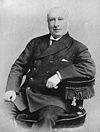 Captain John Henry Jellicoe (1825–1914) of Southampton Captain John Henry Jellicoe (1825–1914) of Southampton |
Samuel Jellicoe (1788–1861), contractor/banker of Millbrook (Hants) then 12, Portland Terrace, All Saints, Southampton. |
Samuel Jellicoe (c1758-1843), ironmaster/contractorof Fontley, then Uplands House, Fareham Fareham The market town of Fareham lies in the south east of Hampshire, England, between the cities of Southampton and Portsmouth, roughly in the centre of the South Hampshire conurbation.It gives its name to the borough comprising the town and the surrounding area... , then of Brighthelmstone, Brighton. |
| Catherine Lee |
|||
| Elizabeth Jane Whalley (Smythe Gardiner) (1792–1872), also of 30 Portland Street, Southampton |
Sir James Whalley Smythe Gardiner, 2nd Bt. (d.1805) of Clerk Hill, Whalley Whalley, Lancashire Whalley is a large village in the Ribble Valley on the banks of the River Calder in Lancashire, England. It is overlooked by Whalley Nab, a large picturesque wooded hill over the river from the village.... , Lancs., & Tackley Tackley Tackley is a village and civil parish beside the River Cherwell in Oxfordshire, England. It is about west of Bicester and north of Kidlington. The village consists of two neighbourhoods: Tackley itself, and Nethercott.-Archaeology:... , & Cuddesdon Cuddesdon Cuddesdon is an east Oxfordshire village about east of Oxford. It is notable as the location of Ripon College Cuddesdon.... (Oxon), & Roche Court, Fareham |
||
| Jane Master |
|||
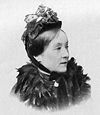 Lucy Henrietta Keele (1834–1916) Lucy Henrietta Keele (1834–1916) |
Dr. John Rushworth Keele (1787–1856) Mayor of Southampton 1823–26 |
John Keele (1760–1835) surgeon of Southampton & Hythe |
|
| Elizabeth Rushworth (1761–1817), daughter of Capt. Edward Rushworth, RN, sister of Edward Rushworth, MP |
|||
| Constantia Patton (1798–1854) |
Admiral of the Red Philip Patton (1739–1815) of Fareham |
||
| Elizabeth Dixon |
Residences

- 14, Highbury Place, Islington, N.1.
- (house of JRJ's great-grandfather, Adam Jellicoe, who died there 30 August 1789)
- 67, Talgarth Road, Fulham, W.14. (visitor, 1891 census);
- 33, Hans Mansions, Hans Crescent, S.W.1. (above HarrodsHarrodsHarrods is an upmarket department store located in Brompton Road in Brompton, in the Royal Borough of Kensington and Chelsea, London. The Harrods brand also applies to other enterprises undertaken by the Harrods group of companies including Harrods Bank, Harrods Estates, Harrods Aviation and Air...
), (c1903); - 25, Draycott Place, Cadogan Gardens, S.W.3. (c1905-1907);
- 29, Sussex Square, Hyde Park, W.2. (c1914,1916, 1919);
- 80, Portland Place, W.1. (c1926-1929);
- 19, Princes Gardens, S.W.7. (c1930);
- 39, Egerton Gardens, Chelsea, S.W. (dies there 20 November 1935).
Isle of Wight:
- St Lawrence Hall, Ventnor, Isle of Wight (1924–1935)
Two of Jellicoe's childhood homes in Southampton:
- 39, Anglesea Place, All Saints, Southampton (1861, census);
- 1, Essex Park Terrace, St. Mary, Southampton (1871, census);
- 12, Portland Terrace, Southampton (1909, an aunt, Miss Jellicoe).
External links
|-

